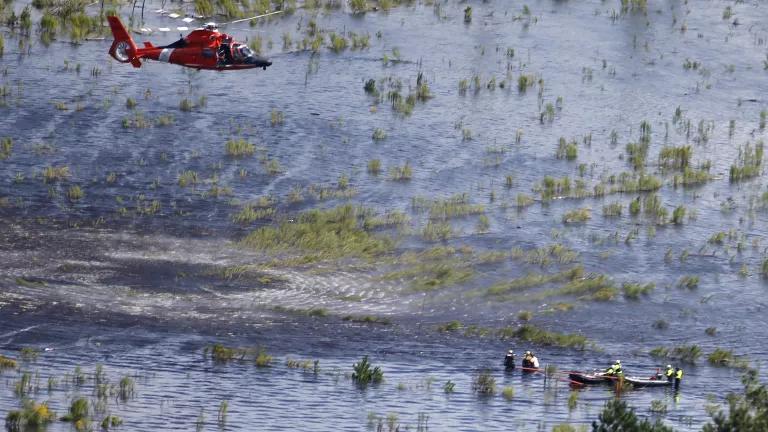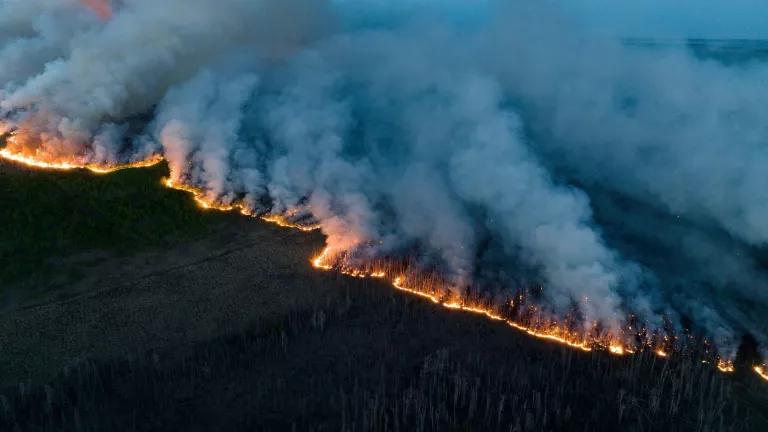Planting Trees Isn't a Climate Plan—It's a Distraction
The truth is, planting trees—even large numbers of them—does not equate to climate leadership, and all this talk of seedlings is a distraction from doing the hard work of eliminating fossil fuels and saving the intact forests we still have.

A good magic trick involves misdirection. While a magician distracts the audience with visual flourishes, the real story is what the audience doesn’t notice. And abracadabra!—the magician makes the mundane seem miraculous when really, they didn’t do much of anything at all.
Now, our global leaders are trying to play that trick on us around climate change, making sweeping-sounding promises about planting one trillion trees, while at the same time remaining complacent on the real solutions, or even actively worsening our climate crisis. Even Donald Trump has jumped on the tree planting bandwagon—parading around his self-proclaimed green thumb while continuing to dismantle our environmental laws, cut down forests, and stall climate action.
Yesterday, House Republicans joined Trump, releasing the proposed Trillion Trees Act, which would commit the U.S. to joining in the international One Trillion Trees Initiative launched this year at the annual meeting of the World Economic Forum in Davos. Oddly, the House Republicans' "climate strategy" has no mention of eliminating or even reducing fossil fuels, which is essential to avoiding the worst of climate change. The Act's title also obfuscates its second, less advertised purpose: growing demand for cutting these trees down.
While the international initiative around planting one trillion trees (over the next 30 years) may sound environmentally friendly on paper, it's allowing governments and corporations to deflect responsibility for environmental misdeeds. The truth is, planting trees—even large numbers of them—does not equate to climate leadership, and all this talk of seedlings is a distraction from doing the hard work of eliminating fossil fuels and saving the intact forests we still have. If we fall for this deflection, we’ll be tending to our saplings while we drive off an environmental cliff.
Planting trees has long been a form of environmental greenwashing. There’s a pernicious myth that if new trees are planted after old ones are cut down, logging is then sustainable. Many companies that sell forest products would have you believe that we can continue cutting down forests without consequence as long as we replant them.
Procter & Gamble, which makes its Charmin toilet paper in part from ancient boreal forests in Canada, touts the fact that, for every tree that’s cut down to make its products, another is regrown. Meanwhile, governments and industry are offering bioenergy—burning trees for energy—as a sustainable energy alternative, pointing to full tree regrowth to show its carbon neutrality.
But the hard truth is that making our toilet paper from virgin forest fiber and burning off our trees for energy has devastating climate impacts that planting more trees simply can’t negate. Each roll of virgin forest fiber toilet paper we flush away has three times the climate impact of toilet paper made from recycled materials.
And while the Trillion Trees Act heralds bioenergy as a clean alternative to fossil fuels, this form of energy has no place in a low-carbon future. Biomass-burning plants emit more carbon dioxide (CO2) from their smokestacks than coal-burning plants per unit of energy, on top of the carbon lost from the forest and the forest's reduced capacity to absorb carbon from the atmosphere.
We can’t afford to flush away our forests and burn them for fuel. Intact forests are critical for regulating atmospheric carbon, and studies have shown that these unlogged forests are far more valuable for the climate than those that were clearcut and regrown.
A forest is a complex web of relationships that take decades or longer to form. As trees die and new ones regrow, carbon builds up in forests over hundreds of years. Just like you can’t throw 1,000 people into a room and call them a family, you can’t simply plant 1,000 trees and call it a forest. A biodiverse, carbon-rich forest develops only with the slow passage of time. Once it’s gone, it can take generations to return.
The Canadian government and forestry industry are particularly egregious about using their tree planting efforts as a “get out of jail free” card. The Canadian boreal forest is the most carbon-dense ecosystem on the planet and one of the last large intact forests left. Yet industry in Canada is clearcutting the boreal at a rate of over a million acres each year to make products like Charmin. While logging companies are required to replant trees, this isn’t enough to make up for the loss of carbon from the soils and vegetation, meaning each year logging in the boreal releases as much carbon as 55 million passenger vehicles.
Industry often exacerbates these impacts by replanting monoculture forests, which are more akin to tree farms, rather than biodiverse stands. Even more alarmingly, a recent report by the Ontario-based group Wildlands League found that entire areas of forest are not coming back at all, meaning deforestation rates in the Canadian boreal could be as much as 50 times higher than the government is reporting.
While President Trump is perhaps the most egregious example of someone using planting trees to distract from climate inaction and assaults on our forests, Canadian Prime Minister Justin Trudeau shares in this hypocrisy. Following Trudeau’s Liberal government’s declaration of a climate emergency, they announced that they would pursue a campaign to plant two billion trees as a means of combatting climate change. However, the source of the revenue for this initiative is none other than the recently approved Trans Mountain Pipeline, which will lock Canada into decades of dirty tar sands oil production and hobble its ability to meet its climate commitments. Furthermore, this commitment to plant more trees doesn’t mean that Canada is any less voracious about cutting down its intact forests, which must remain in place if we are going to avoid climate catastrophe.
Nature-based climate solutions can offer up to one-third of the emissions reductions we need to avoid runaway climate change. But planting trees is only a small part of this, and it cannot be used as justification for continuing to cut down intact forests or replacing natural forests with monoculture tree plantations. And, no matter what, we can’t avoid the worst of climate change if we don’t end our reliance on fossil fuels. No number of newly planted trees can change that.
Last year, the international scientific community called for transformative change to overcome our monumental environmental crises. This entails sweeping, fundamental alterations to our energy systems and an end to the supply chains that drive intact ecosystem loss. With the clock counting down, there’s no time for half measures. Sure, we should plant trees along the way, but we can’t become distracted from the primary task at hand: taking bold, rapid action to end fossil fuels and protect the forests we already have.




